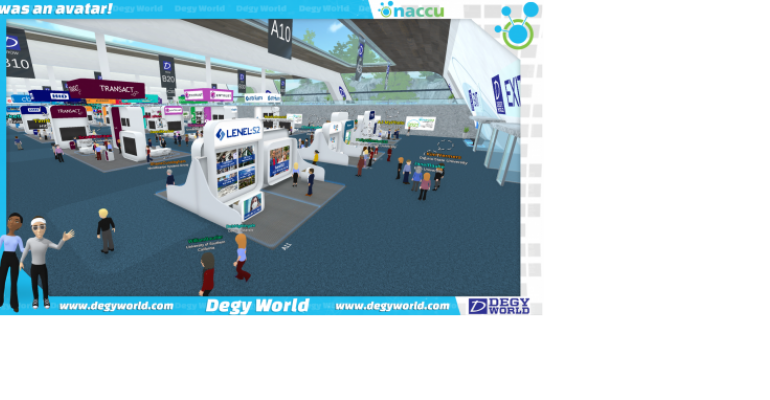When NACCU (formerly the National Association of Campus Card Users) canceled its 2020 annual convention and trade show one month out, John Ogle was pretty worried. The membership engagement manager for the association says that “there was just no way for us to pull off a virtual event in a time frame that worked for our members, who work at institutions of higher learning. They were scrambling as much as we were” to deal with the effects of the Covid pandemic on their business. In short, the revenue picture for NACCU in 2020 was not looking good.
On the other hand, “we made sure to keep reaching out to both our institutional and corporate member segments for their thoughts, and they all felt they still needed to conduct business. Internally, we said, ‘What can we do as an event alternative that would work for them?’ Out of that was born our virtual expo showcases.”
Free for institutional members and $1,000 for the corporate-member host, each showcase was a 60-minute Zoom webinar featuring a pre-recorded product demo broken into two 20-minute presentation segments. Each segment was followed by 10 minutes of live Q&A with the corporate host’s rep. Questions were submitted via a chat forum, then answered live on camera by the rep.
The most common technology glitch: When the presenter was participating in the Q&A from home, “we could have buffering issues because the bandwidth is being shared by the rest of the family.” Ogle reminds presenters to ensure they have exclusive use of the bandwidth for their 60-minute session.
 To keep from overloading institutional members with webinars, Ogle schedules the virtual expo showcases away from topic-focused webinars run by NACCU’s education team. “We won’t do more than two a week, and we find that Tuesday, Wednesday, or Thursday between 11 a.m. and 2 p.m. Eastern time draws the best.” Typical attendance is between 50 and 100 members. What’s more, “with technology changing so quickly around student-identification cards and cashless-payment cards that are moving to touchless mobile apps for both health security and convenience, turnout for the showcases is staying strong,” says Ogle (pictured here).
To keep from overloading institutional members with webinars, Ogle schedules the virtual expo showcases away from topic-focused webinars run by NACCU’s education team. “We won’t do more than two a week, and we find that Tuesday, Wednesday, or Thursday between 11 a.m. and 2 p.m. Eastern time draws the best.” Typical attendance is between 50 and 100 members. What’s more, “with technology changing so quickly around student-identification cards and cashless-payment cards that are moving to touchless mobile apps for both health security and convenience, turnout for the showcases is staying strong,” says Ogle (pictured here).
As a result, NACCU did 33 virtual expo showcases in 2020; all of them can be found on NACCU TV, an area of the association’s website where all its video content resides. Further, the association is continuing to do these showcases throughout 2021 even though its annual event took place virtually in April, using an interesting platform of its own.
Simulated Reality Gets Real Results
Having much of 2020 to develop what the April 2021 version of NACCU’s annual event would look like, Ogle and his colleagues undertook a formidable project: Building a simulated-reality trade-show floor that gets as close as technologically possible to an in-person experience. “Our members said the one thing they weren’t getting enough of from virtual events they attended in 2020 was engagement,” he says.
To solve this, NACCU used the platform Degy World, where attendees create an avatar of themselves that walks the show floor and sees things from the same perspective they would in a physical space. Because each avatar appears with the user’s name, title, and organization overhead, attendees can move towards colleagues they want to meet and, through a feature known as spatialized voice chat, speak through their computer’s microphone to that colleague, who hears the voice clearly above the show-floor murmur. In fact, as the avatars move through the show’s aisles, attendees can hear the conversations of others as they pass by and join in if they choose.
Within exhibitor booths, private conversation spaces are denoted by blue halos overhead. “When you walk underneath a halo, suddenly the sounds from around you are gone,” Ogle says. “Now you can have a conversation without any distraction.”
With NACCU staff explaining the concept to potential exhibitors well ahead of time, “we were able to sell out the simulated exhibit hall,” Ogle notes. One other reason for that: “We changed our registration offer—any institution that registered three or more attendees got one group rate, so people from different departments who would never attend in person chose to participate.” As a result, total attendance was 930 compared to the 2019 in-person event that saw 540 attendees.
“Setting up a simulated trade show was at least twice as much work as doing the in-person version, but it will be easier now that we’ve done it and understand it,” Ogle says. “The bottom line is that people really liked it for the quality of conversations they could have. Many of our exhibitors said, ‘We miss the face-to-face experience, but this environment worked really well for us.’”
While Ogle and the NACCU staff expect to host an in-person convention and trade show in April 2022, the simulated version might be something the association uses to conduct a networking day held midway between annual events.





